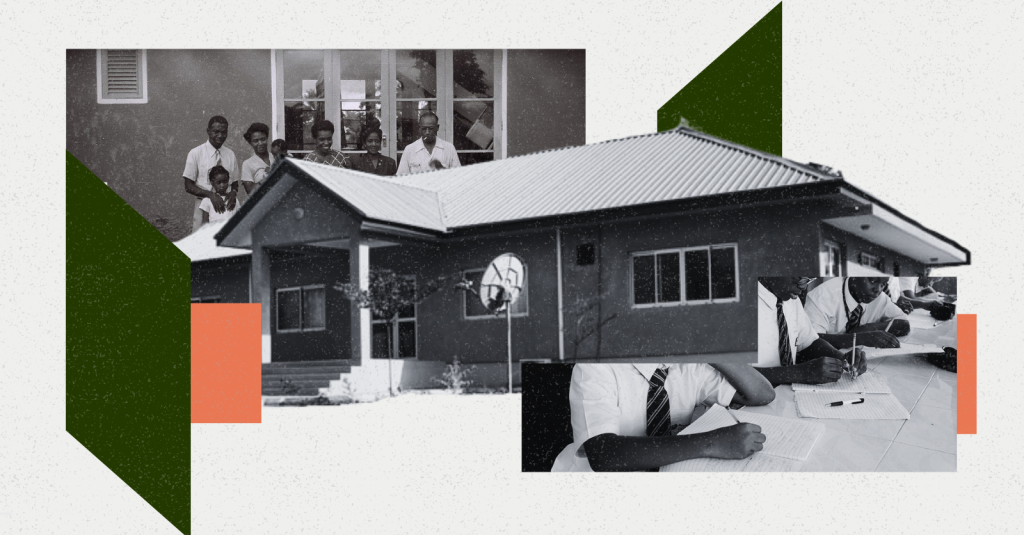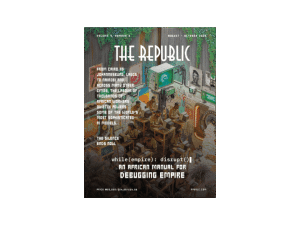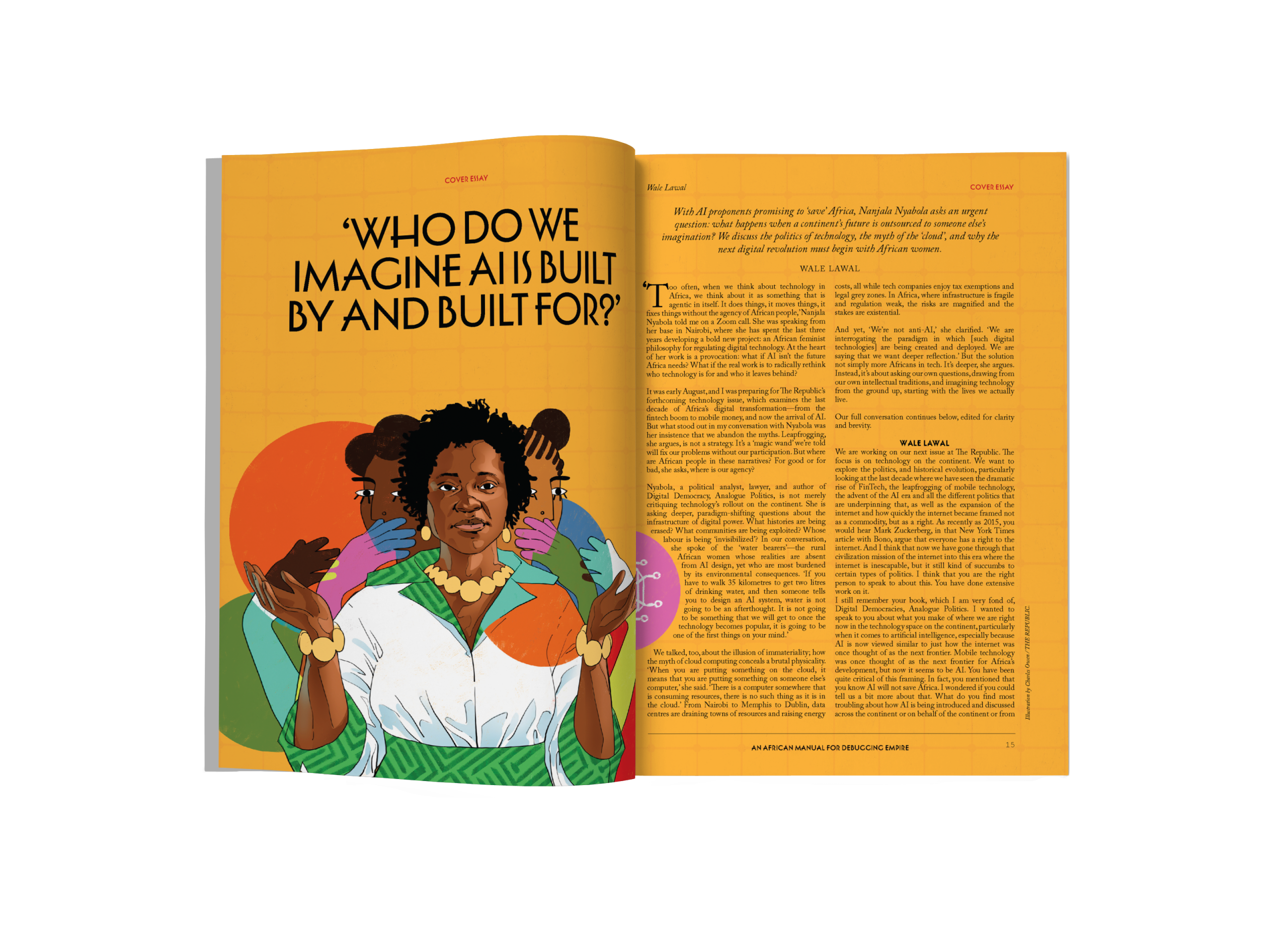
Photo Illustration by Ezinne Osueke / THE REPUBLIC. Source Ref: WIKIMEDIA.
THE MINISTRY OF BUSINESS X THE ECONOMY
The Vanishing Dream of Nigeria’s Middle Class

Photo Illustration by Ezinne Osueke / THE REPUBLIC. Source Ref: WIKIMEDIA.
THE MINISTRY OF BUSINESS X THE ECONOMY
The Vanishing Dream of Nigeria’s Middle Class
In Ilorin, federal university staffer Yusuf Mogaji says his pay check is ‘just for food and the remaining to transport yourself to work, there is nothing left.’ In 2015, his ₦46,000 salary could feed a family and even buy land. Today, despite higher nominal pay, it barely covers rice and nappies. In Lagos, mother of five Antonia Arosanwo waits at a bus stop, her daily ride from Ojuelegba now more than ₦700 since the fuel subsidy removal. ‘I am angry,’ she says, as she is forced to choose each week between food, transport and power. In Abuja, taxi driver Farouk Ibrahim loses hours in fuel queues. ‘No fuel, no light, even to eat is a problem,’ he explains, watching his earnings vanish before he finds passengers. From Ilorin to Lagos to Abuja, and across the nation, the stories converge: Nigerians are being squeezed by a cost-of-living crisis that erodes the basics of daily survival.
This is the reality of middle-class life in Nigeria in 2025: educated, exploited and exhausted. The value of hard work has eroded alongside the value of the naira. Monthly paychecks vanish into rent, diesel and food. For many, the fallback isn’t leisure or savings but an exit strategy. In 2023 alone, the Nigeria Immigration Service issued 2,141,300 passports, an unprecedented surge widely linked to the japa wave. Meanwhile, 63 per cent of Nigerian adults and 73 per cent of youths say they would relocate if they could.
It was not always this way. In the 1960s, Nigeria’s middle class embodied a different kind of hope. Independence brought promises of upward mobility. A university degree meant something. A civil service job came with status, stability and tangible benefits like subsidized housing, car loans, and even a solid pension plan. Parents imagined a better life for their children and believed that life would be lived here, at home. Post-independence, hard work and education were seen as tickets to lives of dignity, security, and national contribution.
Placing today’s fragile reality against that optimistic past shows just how far removed we are from the post-independence ideal. This is not just a story of economic decline; it is the slow fading of a national ideal. How did Nigeria fall so far from that dream?
THE GOLDEN YEARS: HOPE AND NATION-BUILDING (1960s–1980s)
In the first decades after Nigeria’s independence (the 1960s through late 1970s), the country experienced a genuine, if short-lived, golden age for its middle class. The economy, buoyed initially by agriculture and later by an oil boom that saw GDP per capita skyrocket from $93 in 1960 to over $900 by 1980, with an explosive surge of 84.8 per cent growth in GDP per capita in 1970 alone (due to the massive inflow of oil revenues following the end of the civil war). More importantly, this wealth facilitated government policies and public expenditure on infrastructure (roads, communication networks, education) grew significantly, averaging 13 per cent of GDP during 1970-1973 and rising to 25 per cent in 1974-1980 actively supported the emergence of a stable middle class, fostering an era where poverty was low, and living standards were visibly rising.
The government provided amenities that sound almost utopian by today’s standards. For instance, civil servants could get car loans and subsidized housing through the Nigerian Housing scheme as part of their employment benefits. A young graduate who secured a position in the federal or regional civil service could often secure government accommodation and afford a car within a few years. Housing for holders of elite public-sector jobs was often of a standard comparable to the middle class in a developed country.
Education was expanding rapidly, too. The establishment of new universities and secondary schools meant a growing segment of the population obtained higher education, which in turn fed into civil service and professional jobs. A university degree was a virtual guarantee of employment. The first generation of post-independence parents strongly believed in education as the ticket to upward mobility, and for a time, it was. Stories abound of rural families pooling resources to send one child to university, confident that the investment would pay off not just for the graduate but for the entire family. Often it did. That graduate might teach at a secondary school, or work as a bank officer, earning enough to lift siblings and cousins out of poverty.
Crucially, the middle class in this era saw itself as nation-builders. There was a sense of mission: independence had come with the promise that Nigerians would now develop Nigeria, and the middle class was at the forefront of that project.
The oil boom of the 1970s supercharged some of this. With crude exports soaring, government revenues skyrocketed. General Yakubu Gowon famously quipped that Nigeria’s problem was not money but how to spend it. Ambitious projects followed: new universities, infrastructure, even attempts (unevenly executed) at free education and healthcare. Middle-class families benefited as children attended top federal government colleges at little or no cost.
Of course, these golden years were not golden for everyone. Poverty still gripped the majority of the rural population, and stark inequalities persisted between the well-connected urban elites and the average worker. Even as crude oil earnings sent Nigeria’s GDP soaring from about $12.6 billion in 1970 to $64.2 billion in 1980, the average Nigerians saw little relief. Per-capita income stayed below $880 through 1980, briefly jumped to $2,187 in 1981, then fell again, underscoring how unevenly the oil boom’s benefits were distributed. However, the difference is that at the time there was a visible and growing middle stratum, an ‘engine of sustainable development,’ as it was envisioned. And importantly, most of those in that stratum believed their future lay in Nigeria.
In the early 1980s, the idea of leaving Nigeria in search of work was relatively rare and even somewhat stigmatized among the middle class. The mentality was that Nigeria was the land of opportunity for its citizens, or soon would be, once the promises of independence were fully realized. Sadly, that notion would be severely tested in the decades to follow.
THE TURNING POINT: STRUCTURAL ADJUSTMENT AND THE LOST 1990s
For Nigeria’s middle class, the mid-1980s marked the beginning of a steep descent. By 1984, recession was deep, unemployment soared, inflation spiraled, and daily life became a struggle. By 1986, the oil bust and the Structural Adjustment Program (SAP) undercut the security many had come to expect. As global oil prices collapsed, an oil-dependent Nigeria was plunged into a fiscal crisis. Without a proper economic master plan, the country was ill-equipped to handle the oil price crash of the early 80s. Its public investments were largely in costly infrastructure with poor returns and high maintenance bills. Buhari’s austerity and spending, and import cuts only made things harder. In this climate, the iconic Andrew ad captured the mood, with a frustrated young man vowing to check out of Nigeria until persuaded to stay by the promise of better days.
That promise never materialized. Under Ibrahim Babangida’s military regime (1985-1993), SAP brought radical naira devaluation, subsidy removals, trade liberalization, and privatization. In theory, reform meant balance. In practice, it was a sudden free-fall. The naira lost value dramatically, imports grew costly, and fuel hikes drove up living expenses. Public-sector pay froze, jobs were slashed, and civil service hiring slowed to a trickle—shutting down a key mobility ladder for young graduates. The stable middle-class life turned wobbly as real incomes plunged. Fixed salaries were mocked by inflation, and professionals moonlighted to cope, taking on side gigs and small trading to make ends meet, as the idea of a single secure job faded.
Worse still, many of the brightest began to conclude that they had no future in Nigeria. Thus began Nigeria’s first big brain drain. ‘Others sought to emigrate, especially highly skilled people such as doctors, lawyers and professors, who realized they could do much better abroad,’ notes one historical study of Nigerian society in the late 1980s. Nigerian academics and health professionals left in large numbers for Europe, North America, and the Middle East. This was Japa 1.0, long before the term japa became commonplace in public discourse.
For those who remained, the 1990s were years of prolonged uncertainty and decline. The promise of middle-class life virtually disappeared for new entrants into the workforce. Under military rule, especially General Sani Abacha’s repressive regime (1993 to 1998), the economy stagnated and sanctions deepened isolation. Families coped by downsizing dreams: cheaper schools, less protein, and homes left in disrepair. Parents urged children to seize any chance abroad, a stark reversal from two decades earlier.
By 1999, when Nigeria finally returned to democracy, the once vibrant middle class was a shell of its former self. An incisive commentary from The Atlantic noted that ‘what there was of a middle class in the 1960s and 1970s—seen at the time as an engine for sustainable development—has largely disappeared.’ It is a sobering assessment that the social group meant to drive Nigeria’s development had been hollowed out by years of economic mismanagement and political turmoil. As the new millennium dawned and with the promise of democratic governance, the stage was set for either a renaissance or a further unravelling.
shop the republic
-
‘The Empire Hacks Back’ by Olalekan Jeyifous by Olalekan Jeyifous
₦70,000.00 – ₦75,000.00Price range: ₦70,000.00 through ₦75,000.00 -
‘Make the World Burn Again’ by Edel Rodriguez by Edel Rodriguez
₦70,000.00 – ₦75,000.00Price range: ₦70,000.00 through ₦75,000.00 -
‘Nigerian Theatre’ Print by Shalom Ojo
₦150,000.00 -
‘Natural Synthesis’ Print by Diana Ejaita
₦70,000.00 – ₦75,000.00Price range: ₦70,000.00 through ₦75,000.00
FALSE DAWNS: OIL BOOMS, DEMOCRACY AND TECH HYPE (1999–2015)
The end of military rule in 1999 brought a new wave of hope. With democracy restored, Nigerians looked forward to better governance and an economic revival that would rebuild the middle class. The 2000s and early 2010s brought some positives: oil windfalls as crude prices climbed, robust growth of about 7 per cent annually (between 2000–2014), and the 2014 GDP rebasing that made Nigeria Africa’s largest economy (over $500 billion). On the surface, this was the Nigeria is rising story. A nascent middle class re-emerged, visible in packed malls, new car models, and middle-income estates on city outskirts.
The growth was real, but the benefits were deeply uneven and fragile. A 2014 analysis by the Nigerian National Bureau of Statistics (NBS) presciently observed that even after the GDP rebasing that made Nigeria look richer on paper, over 60 per cent of Nigerians were still living on less than $1 a day. While total GDP was rising, much of the population was not experiencing an improvement in living standards. The richest pockets, including a small corporate elite and political class, captured a disproportionate share of the new wealth while the middle segments remained shallow.
The democratic governments of the 2000s introduced reforms to curb corruption, attract investment, and modestly diversify. Yet, institution-building was slow. Power and transport saw little improvement despite rising GDP. Unemployment, especially among youth, stayed high. Much of the new middle-class life rested on shaky ground: banking and telecom jobs vulnerable to downturns, or ventures tied to government patronage. The public sector never regained its old security.as salaries failed to rise with living costs.
Socially, the 2000s middle class in Nigeria became known for conspicuous consumption. GSM phones and social media fueled an image-conscious urban class keen on luxury brands, flashy cars and destination weddings. Lagos, especially, gained a reputation for ‘island high rollers’. Yet, behind many facades lay debt and uncertainty, with spending propped up by loans or fleeting credit. A 2016 McKinsey report found that 65–70 per cent of households in advanced economies saw stagnant or falling incomes from 2005 to 2014. Nigeria, as an emerging economy, was not included, but the parallel is clear: civil servants and teachers often could not recall their last raise, and with inflation running above 15–20 per cent for much of the 2010s, their real incomes fell even faster than in the developed countries McKinsey studied. Yusuf Mogaji’s frozen ₦46,000 salary (once enough to feed a family and even buy land, now barely covering rice and transport) captures this erosion of purchasing power. Even as the country was hailed Africa’s largest economy, millions were merely treading water or sinking in real terms.
However, the rise of the tech sector fueled optimism. By the early 2010s, Nigeria’s tech scene, often dubbed ‘Yabacon Valley’ (after Yaba in Lagos), was blossoming. Young entrepreneurs founded fintech and e-commerce startups that gained international recognition and venture capital funding. Headlines touted an innovation hub; a few exits minted millionaires and hinted at a modern knowledge economy. Yet, the scale was overstated as tech remained a tiny share of the economy and workforce. For a connected few, it offered prosperity and fed the sense that Nigeria was on the cusp of something big, but it did not broadly lift the middle class.
Throughout the 2000s and early 2010s, emigration continued (japa 2.0, one might say) though less desperate than in the 1980s. Many left for education or specialized work, often intending to return, while globalization made travel easier and new destinations opened up. The US visa lottery, UK post-study routes, and Canada’s skilled-worker programmes drew thousands, and by the mid-2010s, Nigeria was among the top 15 countries sending international students to the UK and US. The term IJGB (I just got back) captured the wave of young Nigerians returning for holidays or ventures, even as many quietly planned exits.
Nevertheless, between 2010 and 2015, rising insecurity (Boko Haram, kidnappings and militancy) combined with economic disappointment pushed more Nigerians to leave. Hope lingered as oil prices remained high until 2014, a peaceful 2015 general election and Nigeria’s vast market fueled optimism. International observers hailed Nigeria’s plausible rise as an emerging giant. Yet, for the middle class, the promises rang hollow. By 2015, another oil crash, corruption, a broken grid, weak industries, and meagre savings showed the boom squandered, and a new government inherited an economy sliding into another storm, one that would batter the middle class most.
shop the republic
A CLASS IN CRISIS: THE REALITY OF 2025
If the last decade was difficult for Nigeria’s middle class, the past few years have been nothing short of brutal. By 2025, a convergence of economic strains has pushed the Nigerian middle class to a breaking point, creating a paradox of working poverty, people who have jobs (even professional jobs) but cannot afford the basics of a decent life.
Since 2016, Nigeria has endured repeated shocks: a recession after the oil price crash, a COVID-19 contraction in 2020, and major policy upheavals in 2023. Inflation, long in double digits, spiked to 34.8 per cent by late 2024, with food inflation near 40 per cent as the price of a bag of rice (a core staple) more than tripled between 2020 and 2024. Wages have lagged far behind. The minimum wage rose from ₦30,000 in 2019 (about $83 then) to ₦70,000 in 2023 (roughly $90 after devaluation), yet that sum barely covers two weeks of groceries.
The consistent devaluation of the naira has been another source of chaos. This crisis is rooted not only in 2023’s exchange-rate unification but in a steady naira decline since 2015 that steadily eroded the middle class. In 2023, the government moved to unify the exchange rate in order to prevent arbitrage in the secondary market, causing the official rate to jump from around ₦450 per $1 to about ₦750 per $1 overnight, and subsequently, in 2025, it has floated to ₦1,484 per $1. This means anything with imported content (which is most items, given Nigeria’s limited manufacturing) has become unaffordable. Middle-class parents who dreamed of sending their children abroad for higher education due to Nigeria’s failing public education system can scarcely contemplate foreign tuition fees. Even maintaining a child in a private university in Nigeria is harder, as those institutions hike fees to keep up with costs.
Perhaps the most painful blow came with the 2023 removal of the petrol subsidy. For decades, cheap fuel was one of the few tangible state benefits that propped up all sectors of the economy. With the sudden announcement of its removal, fuel prices shot from about ₦185 to over ₦500 per liter and today stand at about ₦955 in Abuja and ₦915 in Lagos. This subsidy removal trickled into other aspects of the economy, affecting transportation costs and in effect the price of everyday goods thereby shrinking the middle class purchasing power.
Employment has not kept pace with population growth. Youth unemployment hovers at above 40 per cent, underemployment is rampant, and many educated Nigerians survive through gig work or informal hustles. The side hustle has become a defining feature of middle-class life, including Instagram shops, small farms, tutoring gigs, which many households say they could not cope without. Remittances are another lifeline. In 2022-2023, the diaspora sent home about $20 billion, four times more than foreign direct investment and equal to 4 per cent of Nigeria’s GDP. This money helps pay for school fees, medical bills, rent and often the migration of more relatives. Despite these coping mechanisms, the lived reality in 2025 is one of continual anxiety. A 2022 NBS/UNDP report found 63 per cent of Nigerians, 133 million people, are multi-dimensionally poor, including many with jobs but no healthcare or clean water. Even those above the poverty line feel squeezed; they may not be poor, but they cannot afford comfort. Families juggle which essential to pay each month, rent or school fees, while testimonies tell of professionals skipping meals to feed children or riding unsafe motorcycle taxis because they cannot fuel their own cars..
In this climate, exit strategy has become standard in the middle-class vocabulary. A decade ago, emigration was largely for students or doctors; now japa 3.0 spans professions and generations. Passport issuances hit a record 2.14 million in 2023, as Nigerians sought work or study routes abroad. Proposals to bind young doctors to five years’ service captured the desperation. For many households, leaving is less an aspiration than a survival strategy. It is, in effect, a vote of no confidence in the system’s ability to guarantee a future.
shop the republic
WHAT COMES AFTER THE MIDDLE?
Nigeria’s trajectory has led to an unsettling question: what happens to a nation when its middle class, historically the engine of growth, innovation and stability, shrinks to the point of irrelevance or relocates its energies elsewhere? The answers are not encouraging.
A strong, sizable middle class is often cited by political economists as crucial for democracy, social cohesion, and sustained economic development. They are the consumers that drive local businesses, the professionals that run institutions, and the taxpayers that should hold the government accountable. In Nigeria, this group is voting with its feet. If this trend continues unabated, Nigeria risks becoming a country bifurcated between a small, insulated elite and a vast population of underprivileged citizens, with virtually no buffer or bridging class in between. That is a recipe for heightened instability and a perpetuation of poverty cycles.
Can Nigeria stem the tide and rebuild its middle class in this age of global opportunity? It’s an immense challenge, but not an impossible one, at least not theoretically. Doing so would require a radical turnaround in governance and policy direction. Macroeconomic stability is the first step: taming inflation, stabilizing the currency, and ensuring that real incomes can rise. Without that, even patriotic Nigerians will continue to feel compelled to leave simply to preserve their earning power. Additionally, addressing insecurity is paramount. Restoring safety on roads, in farms, and in cities would remove one of the key push factors, as personal safety ranks as a top reason for emigration.
Another key element is opportunity. Nigeria needs to provide avenues for people to fulfil their ambitions at home. This does not simply mean jobs but the creation of careers with long-term viability. Strengthening institutions so that success is not only about who you know or how you can game the system is critical to restoring faith. That ties into tackling corruption, because a society where the rule of law is weak will always see the honest middle-class strivers feel cheated and disillusioned.
There is also the question of the diaspora’s relationship with Nigeria. Today, much of the middle class is already abroad or preparing to leave, as younger Nigerians raised with global exposure compare themselves not just with neighbours but with peers worldwide. Their tolerance for ‘waiting it out’ is low; they want a good life now, and they see clearer pathways elsewhere. This generational impatience fuels the japa wave, but it also creates an opportunity. Other countries have shown that brain drain can become brain gain. India and China, for instance, drew back professionals in the 2000s as opportunities improved. Nigeria’s 17-million-strong diaspora is influential through remittances, skills and cultural ties, and many still harbour hopes of returning, but only if conditions markedly improve at home. The challenge, then, is to transform the diaspora from a one-way exit channel into a genuine partner in development. Gestures from the Nigeria Diaspora Commission exist, but without tangible progress (reliable power, inflation easing, functional schools and hospitals, accountable leadership) such efforts will fall flat. Reversing the japa tide and reviving the middle class ultimately depends on restoring hope, the kind my grandparents knew in the 1960s, grounded not in slogans but in visible progress.
What future remains if the people meant to build the country are the first to leave it? This question should haunt Nigeria’s leaders and policymakers. A nation can endure losing natural resources (oil can dry up) or temporary capital flight, but losing its motivated middle population en masse is far more difficult to recover from. However, within that question lies a sliver of optimism: those meant to build the country have not vanished; they are merely scattered. They exist in Lagos and London, Abuja and Atlanta, Kano and Calgary. If Nigeria can find a way to bridge the psychological and literal distance, to give its talented sons and daughters a reason to believe again, then perhaps the story can yet change from one of exodus to one of return and rebuilding. Until then, the middle-class dream in Nigeria remains vanishing, spoken about in nostalgic tones by those old enough to remember, and in wistful, cynical tones by those young enough to feel it was taken from them before it ever materialized⎈
BUY THE MAGAZINE AND/OR THE COVER
-
‘The Empire Hacks Back’ by Olalekan Jeyifous by Olalekan Jeyifous
₦70,000.00 – ₦75,000.00Price range: ₦70,000.00 through ₦75,000.00 This product has multiple variants. The options may be chosen on the product page -
The Republic V9, N3 An African Manual for Debugging Empire
₦40,000.00
US$49.99












